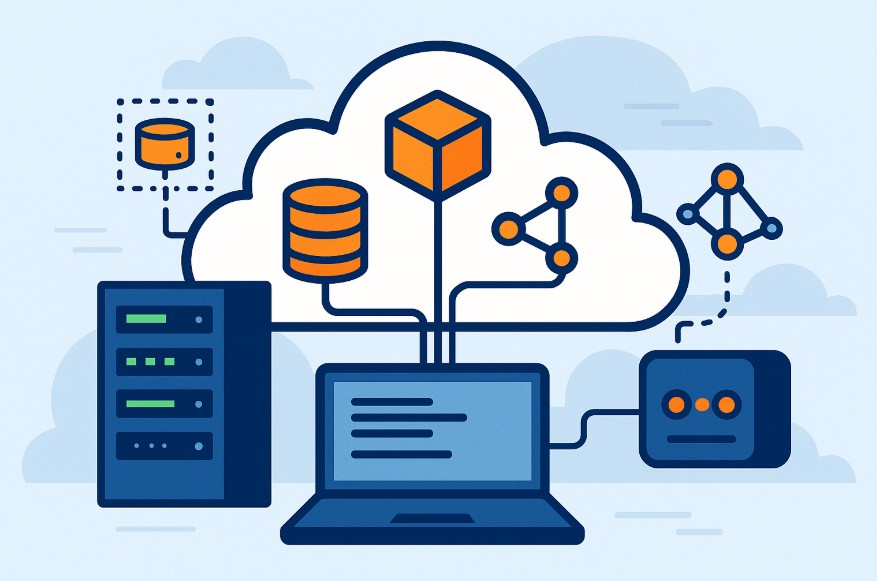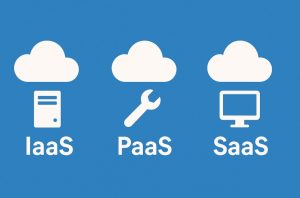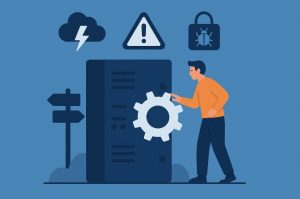
In the ever-evolving digital economy, cloud computing has emerged as a transformative force enabling businesses to innovate, scale, and operate more efficiently. Among the various service models in cloud computing,
Infrastructure as a Service (IaaS) stands out as the backbone of enterprise IT modernisation. It offers virtualised computing resources over the internet, replacing the traditional need for in-house data centres and physical servers.
IaaS empowers businesses, startups and multinational enterprises alike, to build, test, host, and scale applications rapidly without the constraints of hardware maintenance and provisioning delays. This article explores what IaaS is, how it works, its role in cloud computing, and why it’s particularly valuable in the Indian business context.
What Are Cloud Infrastructure Services?

Cloud infrastructure services refer to the delivery of core IT elements, compute, storage, and networking, through remote, internet-connected environments. These services serve as the foundation for deploying and running software, applications, and platforms in the cloud.
Unlike traditional infrastructure, which requires significant upfront investment and physical management, cloud infrastructure is available on-demand, which allows companies to pay only for the resources they consume. This flexibility introduces operational efficiency and scalability that legacy systems cannot match.
IaaS is a specific type of cloud infrastructure service that delivers this virtualised environment in a highly automated, self-service format.
How Does IaaS Work in Cloud Computing?
At its core, Infrastructure as a Service (IaaS) is about delivering compute, storage, and network resources via the internet. In this model, a cloud service provider (CSP) hosts the infrastructure components traditionally found in an on-premises data centre, including:
- Physical servers
- Networking hardware
- Storage systems
- Hypervisors (virtualisation platforms)
Customers rent these resources and use them to run operating systems, host applications, manage data, and perform computing tasks. The customer has significant control over the virtual machines, networks, and storage volumes, allowing them to configure environments precisely to their requirements.
How Do Virtualisation and Automation Power IaaS?
The power of IaaS lies in virtualisation. Providers use hypervisors to partition physical servers into multiple virtual machines (VMs), each capable of running its own operating system and applications independently. This enables multiple tenants to share the same physical infrastructure securely and efficiently.
Automation tools and APIs provided by the IaaS vendor simplify provisioning, deployment, monitoring, and management of resources, making it possible to scale infrastructure programmatically in real-time.
What Are the Key Components of IaaS?

A complete IaaS environment includes several interdependent components. These elements work together to form a cohesive, scalable IT framework:
What Are Compute Resources in IaaS?
These are virtual machines (VMs) or containers configured with specific CPU, RAM, and disk space requirements. They run operating systems and applications just like physical servers.
What Types of Storage Solutions Are Used in IaaS?
Storage in IaaS environments can be categorised into:
| Storage Type | Description | Ideal For |
| Block Storage | Emulates a physical hard drive. Provides low-latency I/O | Databases, performance-critical apps |
| File Storage | Organises data in file systems accessible over networks | Shared file systems, content storage |
| Object Storage | Stores unstructured data as objects with metadata | Backups, large media files, archives |
What Networking Infrastructure Is Provided in IaaS?
IaaS provides software-defined networking (SDN), which includes:
- Virtual switches and routers
- Firewalls
- Load balancers
- VPN gateways
- Public and private IP address management
What Are Resource Management Tools in IaaS?
Cloud dashboards and APIs enable administrators to provision resources, monitor performance, implement security policies, and scale infrastructure.
How Is Security Managed in an IaaS Model?
IaaS vendors integrate access control, data encryption, compliance tools, logging systems, and identity management systems as part of the infrastructure.
What Are the Business Benefits of Using IaaS?
The widespread adoption of IaaS across industries is driven by its wide-ranging benefits that align with business goals such as growth, agility, and cost optimisation.
How Does IaaS Offer Economic Efficiency?
One of the most significant advantages of IaaS is cost reduction. Instead of investing in physical hardware, businesses rent resources on an as-needed basis. This approach turns capital expenses into operational expenses, making financial forecasting more manageable.
How Does IaaS Increase Speed and Flexibility?
With IaaS, infrastructure provisioning takes minutes rather than weeks or months. This accelerates software development lifecycles, supports faster go-to-market strategies, and enhances organisational responsiveness to changing market conditions.
How Does IaaS Support Scalability?
Organisations can instantly adjust resources to match workload demands. For example, an e-commerce platform can increase capacity during a festive sales season and scale down afterward.
How Does IaaS Enhance Organisational Productivity?
Since the cloud provider handles the physical infrastructure, internal IT teams can redirect their focus to innovation, software development, or other high-value initiatives rather than managing servers.
How Does IaaS Deliver Built-In Reliability?
Leading IaaS platforms offer high availability zones, automatic failover, data replication, and disaster recovery support to ensure business continuity.
How Does IaaS Compare with PaaS and SaaS?

The three primary cloud service models, IaaS, PaaS, and SaaS, differ based on the level of control, management, and abstraction they offer.
| Service Model | You Manage | Provider Manages | Typical Use |
| IaaS | OS, middleware, applications | Virtualisation, servers, storage, networking | Full control over environment |
| PaaS | Applications and data | Everything below runtime and platform tools | App development and deployment |
| SaaS | Nothing | Entire application stack and infrastructure | End-user applications like email, CRM |
Each model serves a distinct purpose. IaaS is ideal when you need granular control and flexibility, whereas PaaS and SaaS simplify application deployment and end-user delivery, respectively.
Who Are the Leading IaaS Providers in the Market?
Globally, the IaaS market is dominated by tech giants offering robust, scalable platforms. The top providers include:
- Amazon Web Services (AWS): Known for its wide range of services and scalability.
- Microsoft Azure: Preferred for hybrid cloud capabilities and integration with Microsoft tools.
- Google Cloud Platform (GCP): Popular for data analytics and machine learning support.
- IBM Cloud: Offers enterprise-focused solutions with built-in AI tools.
- Oracle Cloud: Favoured for applications requiring high-performance computing and databases.
In India, regional providers are also making significant strides:
- Netmagic (An NTT Company): Offers cloud and data centre solutions tailored to Indian compliance needs.
- CtrlS Datacenters: Known for Tier 4 certified data centres and reliability.
- NxtGen: Provides hybrid and private cloud infrastructure for Indian enterprises.
These local providers offer competitive latency, data sovereignty compliance, and cost benefits for Indian businesses.
How Is IaaS Used in Real-World Business Scenarios?
IaaS supports a wide range of business use cases across sectors such as banking, retail, healthcare, logistics, and technology.
- Web Hosting: Businesses host websites and applications using IaaS for high availability, traffic management, and security.
- Development and Testing: Developers can create isolated test environments that mirror production without incurring additional hardware costs.
- Disaster Recovery: IaaS enables cost-effective backup strategies and ensures continuity during unexpected outages or cyber incidents.
- High-Performance Computing (HPC): Industries such as pharmaceuticals, finance, and engineering rely on IaaS for compute-intensive simulations and modelling.
- Big Data and Analytics: Organisations leverage scalable storage and processing power in IaaS to run analytics, AI, and machine learning workloads.
What Are the Challenges and Risks in Adopting IaaS?

Despite its advantages, adopting IaaS comes with specific challenges that must be managed to ensure success.
How Does the Shared Responsibility Model Affect IaaS Security?
In IaaS, the cloud provider secures the physical infrastructure and some platform services, but customers are responsible for:
- Data protection
- Application security
- Access controls and user permissions
A lack of understanding of this shared responsibility model can lead to security lapses.
What Is Vendor Lock-In and Why Is It a Concern with IaaS?
Different IaaS providers have proprietary APIs and services. Migrating applications between platforms may require significant code changes and integration effort.
How Do Complexity and Skill Gaps Impact IaaS Adoption?
Managing a virtual infrastructure requires a solid understanding of cloud architecture, cost management, and automation tools. Organisations need to upskill their IT teams to extract maximum value from IaaS.
What Does the Future Hold for IaaS in Cloud Computing?
The future of IaaS is defined by deeper integration with advanced technologies and evolving customer expectations. Some anticipated developments include:
How Will AI Transform IaaS Platforms?
IaaS platforms are increasingly integrating artificial intelligence and machine learning to manage infrastructure provisioning, monitor security threats, and optimise performance.
How Are Serverless and Container-Native Architectures Changing IaaS?
As organisations aim to reduce infrastructure management overhead, serverless computing and container orchestration (e.g., Kubernetes) are gaining momentum, complementing traditional IaaS offerings.
How Is Edge Computing Being Integrated into IaaS?
To reduce latency and enhance user experiences, IaaS providers are deploying edge nodes closer to end-users, particularly in regions like India where connectivity and compliance play critical roles.
How Are Industry-Specific IaaS Solutions Evolving?
Customised IaaS platforms tailored to verticals like healthcare, manufacturing, and finance are emerging, offering compliance-ready and optimised environments for industry-specific needs.
How Can Businesses Embrace IaaS for Scalable Growth?
Implementing IaaS effectively requires strategic planning, continuous monitoring, and strong vendor relationships.
- Define Business Objectives: Understand which workloads will benefit most from IaaS.
- Assess Readiness: Evaluate current IT capabilities and identify skill gaps.
- Select the Right Vendor: Consider scalability, support, security features, and pricing models.
- Start with a Pilot: Begin with a non-critical workload to test performance and integration.
- Develop Governance Policies: Establish cost controls, security rules, and usage monitoring.
- Scale Gradually: Migrate additional workloads as the internal team gains expertise.
Successful adoption leads to faster innovation cycles, reduced costs, and increased operational agility.
What are the Frequently Asked Questions About IaaS Cloud Computing?
How does IaaS differ from traditional hosting?
Traditional hosting provides fixed resources, while IaaS offers flexible, scalable infrastructure on-demand with self-service capabilities.
Can I use IaaS for regulated industries?
Yes. Leading providers offer compliance certifications (e.g., HIPAA, GDPR, ISO) suitable for industries like finance and healthcare.
Is IaaS suitable for startups?
Absolutely. IaaS enables startups to access enterprise-level IT infrastructure without high upfront costs.
What are the key features to look for in an IaaS provider?
Scalability, global presence, support for automation, robust security, transparent pricing, and compliance capabilities.
Can I use IaaS in a hybrid cloud setup?
Yes. IaaS integrates well with on-premises infrastructure, allowing hybrid cloud strategies to manage sensitive data and legacy systems.
How does IaaS support innovation?
By reducing infrastructure barriers, developers and businesses can experiment, deploy, and scale new ideas quickly and cost-effectively.
What is the difference between IaaS and serverless computing?
IaaS provides infrastructure you manage, while serverless abstracts even the infrastructure layer, letting you run code without managing servers.